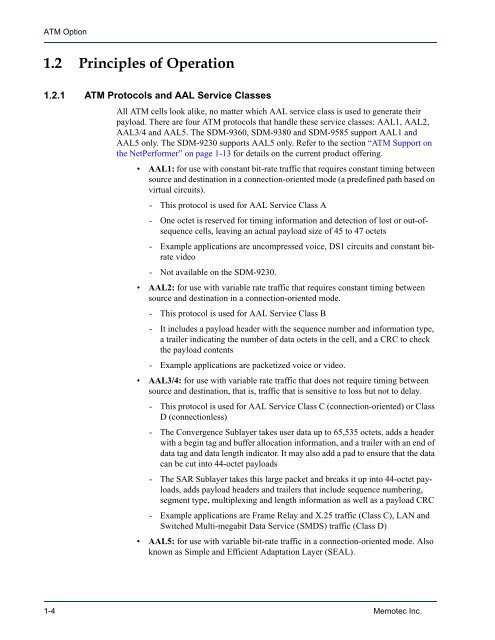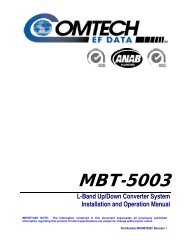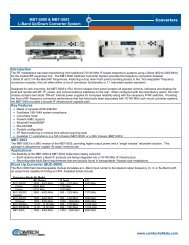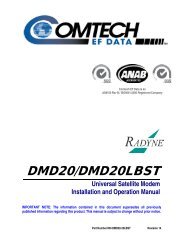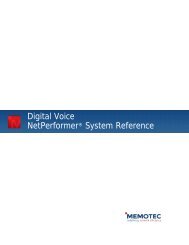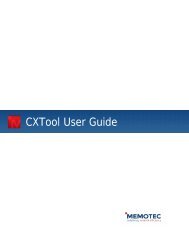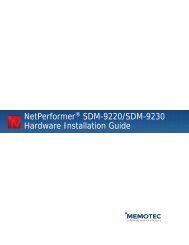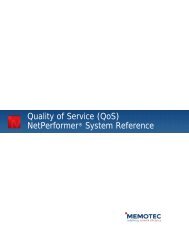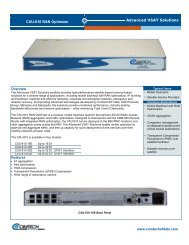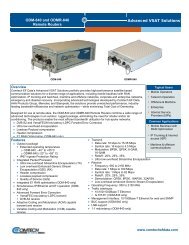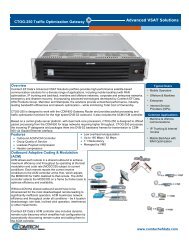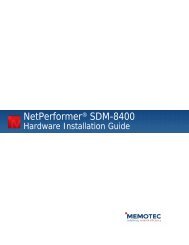ATM Option System Reference - Comtech EF Data
ATM Option System Reference - Comtech EF Data
ATM Option System Reference - Comtech EF Data
You also want an ePaper? Increase the reach of your titles
YUMPU automatically turns print PDFs into web optimized ePapers that Google loves.
<strong>ATM</strong> <strong>Option</strong><br />
1.2 Principles of Operation<br />
1.2.1 <strong>ATM</strong> Protocols and AAL Service Classes<br />
All <strong>ATM</strong> cells look alike, no matter which AAL service class is used to generate their<br />
payload. There are four <strong>ATM</strong> protocols that handle these service classes: AAL1, AAL2,<br />
AAL3/4 and AAL5. The SDM-9360, SDM-9380 and SDM-9585 support AAL1 and<br />
AAL5 only. The SDM-9230 supports AAL5 only. Refer to the section “<strong>ATM</strong> Support on<br />
the NetPerformer” on page 1-13 for details on the current product offering.<br />
• AAL1: for use with constant bit-rate traffic that requires constant timing between<br />
source and destination in a connection-oriented mode (a predefined path based on<br />
virtual circuits).<br />
- This protocol is used for AAL Service Class A<br />
- One octet is reserved for timing information and detection of lost or out-ofsequence<br />
cells, leaving an actual payload size of 45 to 47 octets<br />
- Example applications are uncompressed voice, DS1 circuits and constant bitrate<br />
video<br />
- Not available on the SDM-9230.<br />
• AAL2: for use with variable rate traffic that requires constant timing between<br />
source and destination in a connection-oriented mode.<br />
- This protocol is used for AAL Service Class B<br />
- It includes a payload header with the sequence number and information type,<br />
a trailer indicating the number of data octets in the cell, and a CRC to check<br />
the payload contents<br />
- Example applications are packetized voice or video.<br />
• AAL3/4: for use with variable rate traffic that does not require timing between<br />
source and destination, that is, traffic that is sensitive to loss but not to delay.<br />
- This protocol is used for AAL Service Class C (connection-oriented) or Class<br />
D (connectionless)<br />
- The Convergence Sublayer takes user data up to 65,535 octets, adds a header<br />
with a begin tag and buffer allocation information, and a trailer with an end of<br />
data tag and data length indicator. It may also add a pad to ensure that the data<br />
can be cut into 44-octet payloads<br />
- The SAR Sublayer takes this large packet and breaks it up into 44-octet payloads,<br />
adds payload headers and trailers that include sequence numbering,<br />
segment type, multiplexing and length information as well as a payload CRC<br />
- Example applications are Frame Relay and X.25 traffic (Class C), LAN and<br />
Switched Multi-megabit <strong>Data</strong> Service (SMDS) traffic (Class D)<br />
• AAL5: for use with variable bit-rate traffic in a connection-oriented mode. Also<br />
known as Simple and Efficient Adaptation Layer (SEAL).<br />
1-4 Memotec Inc.


